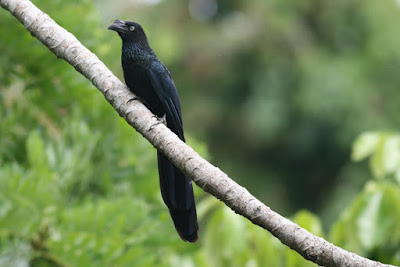 |
| A greater ani; photo by Arthur Chapman, CC BY 2.0 license |
Daily Life of the Bird
Greater anis live in tropical lowland forests next to water. Cornell University says that not much was known about the birds until recently. A boat is often needed to find them and they fly quickly to another location when disturbed. Research is gradually revealing details about their lives, although some need to be confirmed and more need to be discovered.
The birds are very social. They live in flocks that maintain a territory. They feed in a loose group and eat insects and occasionally small vertebrates, such as lizards and frogs. They occasionally feed on fruit. The birds give frequent contact calls as they forage so that individuals know where the other members of their group are located. They climb down branches that reach the water to drink.
The birds roost in large groups, except during the breeding season. They rarely come to the ground, but when they do, they move by walking or hopping. They sometimes enter the water and are strong swimmers. They seem to like sunbathing and sometimes raise their wings as they perch on a sunny day. They also raise their wings after rain, presumably to dry them. The birds preen frequently.
Greater anis are said to have an unpleasant smell, especially when they are in a group. When they are close together, the birds often call at the same time. Christina Riehl a behavioral ecologist at Princeton University, says that the group call "sounds like an outboard motor or an eggbeater."
 |
| Another greater ani; photo by Dominic Sherony, CC BY-SA 2.0 license |
Reproduction
Unlike typical cuckoos, greater anis usually gather in groups of two or three pairs to build a communal nest. All of the females in the group lay their eggs in this nest and each bird guards all the eggs instead of just their own. The nest is made of leaves and twigs and the eggs are piled on top of each other, as a photo in the last reference below shows. As some reports say, the birds seem to be putting all of their eggs in one basket. The eggs are covered by a calcium carbonate layer and are white at first. As this layer is gradually removed by activities in the nest, a blue layer is revealed.
According to the Cornell Lab of Ornithology, "all of the individuals in the group" build the nest, protect the eggs, incubate them, and feed the hatched youngsters. While this might seem like an ideal society, researchers have discovered that a female sometimes throws an egg laid by another bird in the group out of the nest before she has laid her own egg. Once she has laid her first egg, however, she no longer ejects others. The group dynamics need to be studied further.
Scientists have also discovered that if the communal nest is destroyed by a predator such as a snake, the birds may revert to typical cuckoo behaviour. The females may produce more eggs and deposit them in the nests of other greater anis (but not in the nests of other species). Here the eggs will hopefully be protected and eventually hatch. Some females simply wait until the next year to breed again, however. Incubation seems to last for somewhere between eleven and fourteen days.
Researchers have studied the breeding success of the birds that become parasitic and the ones that rear their young in a communal nest. They've found that while the birds that become parasites lay more eggs in a year, the parasites and the communal mothers produce about the same number of offspring.
Discovering More About Greater Anis
Hopefully researchers will discover more about greater anis and their lives in the near future. Some sites reference information about the birds that was discovered in the 1940s. This information isn't necessarily wrong. With the newer research equipment and techniques that exist today, however, it should be possible to obtain more accurate or more detailed facts about the species. I would like to know more about the community activity at the nesting site and to discover or confirm information about the relative roles of the males and the females. It will be interesting to see what scientists discover next.
References
Crotophaga major facts from the Cornell Lab of Ornithology
Information about the greater ani from BirdLife International
Put eggs all in one basket or spread them around? from the ScienceDaily news service
A parasitic cuckoo from Science News
No comments:
Post a Comment